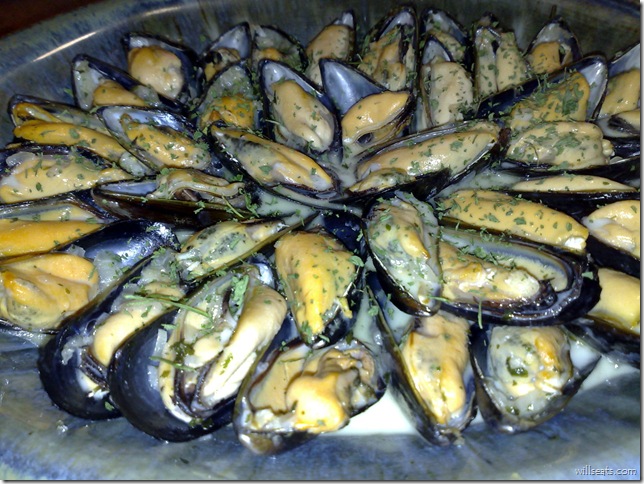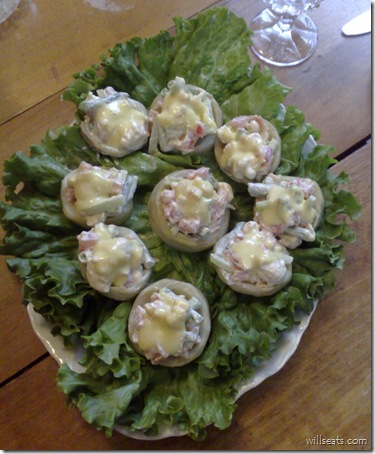By the way, this is the 501st post to the blog.
edited: changed the title to reflect the actual contentHere's an attempt to do the entire day in one post rather than spreading it over several days (one day per dish).
Yesterday's menú was:
Tarte à l'Oignon : Onion Tart
Mouclade : Mussels with Wine and Cream Sauce
Bavarois à la Vanille, Coulis de Framboise : Vanilla Bavarian Cream with Raspberry Sauce
Supplemented with: No Knead Bread, some soft brie-like cheese from Quebec called Brioka (occupying a position between Brie and Oka cheeses) and an additional dessert of Chocolate Cake with Strawberries. And wine - not to forget the wine.
Yikes! Total for this menu: eggs = 8 yolks & 3 whole eggs; butter = 1 pound (about 30 tablespoons); cream = 1 1/2 liters (6 cups) & 1 C milk
The Onion Tart is more or less a quiche - and absolutely completely entirely delicious. Made 2 of these to accommodate the large appetites at the table.

Quiche generally uses whole eggs and milk in the "custard" mix whereas this uses egg yolks and crème fraiche instead; a bit richer than a regular quiche, as is usual with these Cordon Bleu recipes. And quiche most often mixes the "main" ingredient with the eggs and milk - this tart doesn't.
What I did was:
Tarte de l'Oignon : Onion Tart
Serves: 6
Ingredients
- 1 Pâte Brisée recipe [tart crust]
- 1 2/3 C flour
- 1 t salt
- 1 t sugar
- 7 T butter (cold)
- 3 T ice water
- Caramelized Onions
- 1/2 kg onions, fine julienne [sliced fine] [1#]
- 6 T butter
- salt
- pepper
- Custard
- 2 egg yolks
- 1 egg
- 1 C crème fraiche (homemade)
- nutmeg
- salt
- pepper
Procedure
- Make the tart
- Flour, salt, sugar into the food processor bowl - pulse to mix
- cold, cubed butter into the bowl - pulse pulse pulse - until a grainy, sand-like, blend - large grains
- add 1 T ice water and mix briefly to blend
- keep adding 1 T ice water at a time, mixing briefly each time, until the dough maintains its shape when you pinch it between your thumb and 2 fingers
- turn out onto the granite countertop (or whatever) and "knead" it briefly by pushing it away from you a bit at a time with the heel of your hand
- form into a flat disk and stick it in the fridge for an hour (or more)
- Make the caramelized onions
- a lot of butter into a large pan, medium low heat
- cook onions until soft (not colored) (could take 20 minutes)
- coating with butter and stirring occasionally
- heat to low and stir occasionally for 40 minutes or so - when they will be golden colored and sweet
- season with salt and pepper
- Cook the tart shells (blind bake)
- Take the dough out of the fridge, split in two equal pieces and wait 10 minutes
- Roll out to be quite a but bigger than the quiche/tart pan-mold is around
- Place into the mold; no stretching of the dough, please.
- Prick the bottom all over with a fork, lay in a large piece of parchment paper, fill with rice (or dried beans or something like that) to keep the pastry flat
- 200 C [400 F] for 15 minutes
- Remove paper and rice (save the rice)
- Brush a beaten up egg over the pastry surface (bottom and sides) and back into the oven for 10 minutes to set the egg
- Fill the pastry shell with caramelized onions
- Beat together 1 egg (which I had left over from repairing a broken crust edge), 2 yolks, and a cup of crème fraiche; add nutmeg, season with salt and pepper
- Pour over the onions (see notes re: leaking)
- Bake at 185C [375F] for 15 minutes - that is, until the egg mixture is obviously set and probably puffed up a bit - perhaps nicely browned as well
Notes
- 22 cm [9"] tart/quiche pan
- Made a double recipe (two quiche pans) - - but forgot to double the tart dough; oops. Rolled it out very very thin & carefully and it, amazingly, worked out okay.
- I didn't follow the recipe in the book because I didn't have cake flour and because I, lazily, wanted to use the food processor to do the pâte brisée - which I know it does very very well.
- Always, we mean unsalted butter
- Crème Fraiche: 1 C heavy cream and 1 T buttermilk left to sit in a covered container on the counter for a day and a half
- No sugar, no balsamic, no nothing, in the onions expect butter, salt and pepper - very purist. Caramelized onions don't need sugar if done properly
- Will later be testing the baked rice to see if, after 15 minutes in a hot oven, it still cooks like rice
- The egg on the pastry is to keep it sealed from the wet ingredients
- If a piece of pastry edge breaks off you cut use egg as glue to sick it back on
- If the side or bottom has a hole/gap in it fill it with a little ball of bread and wipe it with egg - you want the bottom/sides of the pastry to be leak-proof
- If the pastry shell leaks anyway, put a (preferably non-stick) pan under the leak; which will seal up once the oven heat hits it - fairly quickly, albeit messily.
Yikes again! That was a fairly long dissertation about the tart; which was, by the way, utterly delicious.
Being that it took so long to write this post I'm not going to get to the other two parts of it today. Alas. Maybe tomorrow I can get both the mussels and the bavarois documented.
This was, as always, more or less Lesson 6 from the book Le Cordon Bleu: At Home - a favorite.



































